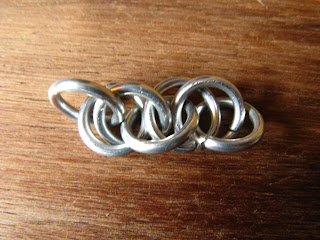Let me introduce you to my favorite chain weave. Why my favorite? Because it's the first one I've "made up", without referring to any guides. I was looking for a way to make an extra-strong chain, and came up with hooking each link through the previous two. Thus, I don't know if it is widely known, has a name, or if anybody actually uses it -- especially it has a property that might make it undesirable, but for me, adds to its charms. It is unstable; or rather, it morphs.
The first thing to do is get yourself a pair of pliers, preferably the type that has a compression spring to keep it open when you're not squeezing the handles. I've just been using a pair of multitools (a Leatherman and a random one I got from my sibling). Then you need rings, which you can either make (a topic for later!) or buy. I got these from
The Ring Lord (0.4 lbs of Bright Aluminum rings for about $17)... I will definitely buy in bulk in future -- about $10.50 of that was shipping -- but I didn't know if I was going to be sticking with this hobby.

The rings come like this, not open but not closed either. Our first order of business is to open lots of them, wide enough that you can pass another ring through the opening. Open them to the side, twisting, not pulling.

Now we can begin. Close one ring all the way and hook an open one onto it, then close.

Hold these two together so that they lie semi-flat against each other. Then hook another open ring through them both at once. Continue to hold the last few rings flat(-tishly) together while hooking new rings in; this will keep your spiral going in the same direction. Otherwise, it will not produce the helix.

Yes my fingernails are dirty.

Shut up.

At the start, it may appear that you're doing everything wrong, because if you set the chain down it looks like this: messy and disordered. Don't worry; it always does.

But once you get a decent few rings together, it starts to look like something you'd like to attach to yourself.

I usually just fabricate a clasp from some scrap copper or brass wire, but this guy wanted it to just go over his head, so I attached the ends together such that it stays in "helix" configuration (twist and attach with a couple more rings) and added a little tail of chain to which he could attach his keys. I didn't really get a good picture, though, so this is what you get.

So, why do I like it so much? Well, you twist it one way, and it does this:

And then you twist the other way, and it does this:

. . . which I think also looks pretty cool. In this form, it looks like what it is: two chains interlocked. Each link is also pretty loose this way, so you can make it make noise. :)
These two pictures are actually of my first piece of helix, which is about double the length of a loose bracelet, which also happens to fit perfectly as a choker. So it can look four different ways, and makes a VERY good fidgety object. (Twist, untwist, double-twist, pluck so it rattles...)
I might put up images of what happens if you twist it further in either direction, but probably won't get around to it. Ah well.


 And another for extra credit.
And another for extra credit.


















































